When cooking meat in your solar oven, you'll need to hit specific internal temperatures for safety: 165°F for poultry, 160°F for ground meats, and 145°F for whole cuts of beef, pork, lamb, and veal. Start by preheating your solar cooker for an hour between 11 AM and 3 PM for ideal sun exposure. Use a probe thermometer inserted into the thickest part of the meat, avoiding bones and fat, to check temperatures accurately. Remember to rotate your food every 10-15 minutes for even cooking, and always let meat rest for three minutes after reaching target temperature. There's much more to mastering the art of solar meat cooking than just temperatures.
Understanding Solar Oven Temperature Ranges
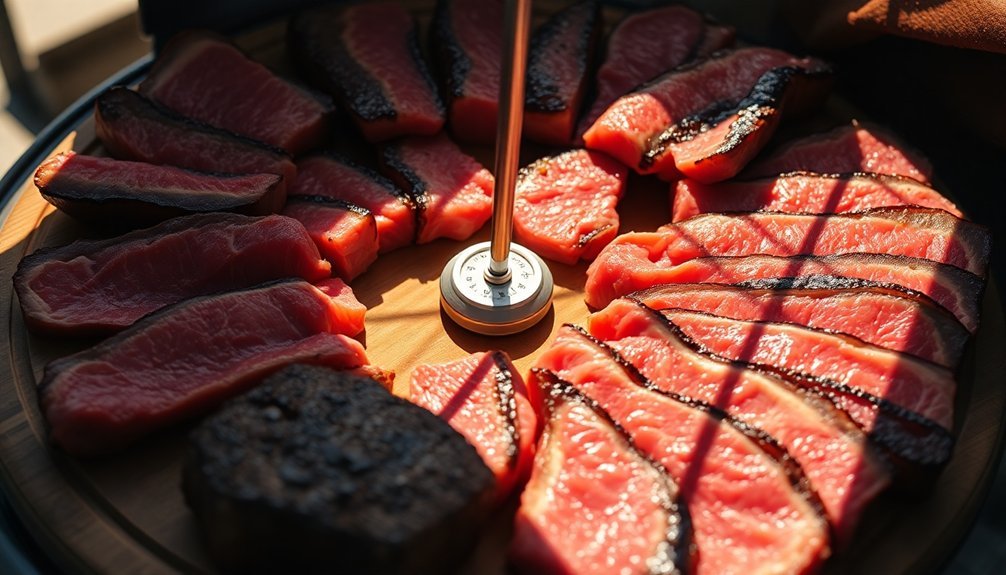
While solar cooking may seem mysterious at first, understanding temperature ranges is essential for successful outdoor cooking. Your choice of solar oven directly impacts the temperatures you'll achieve: parabolic cookers can reach an impressive 800°F, while box ovens typically max out around 350°F.
Panel cookers and portable units operate at lower temperatures, usually between 210°F and 260°F. Good insulation helps maintain consistent cooking temperatures throughout the day.
You'll get the best results by cooking between 10:00 a.m. and 2:00 p.m., when the sun is strongest. Keep in mind that weather conditions and your location affect performance.
To maintain ideal temperatures, use dark-colored pots with tight-fitting lids, and avoid aluminum foil which can reflect heat away. Well-insulated ovens with quality reflectors will help you achieve and maintain higher temperatures for more effective cooking.
Essential Meat Safety Temperatures
When cooking meat in a solar oven, reaching and maintaining safe internal temperatures isn't just about food quality – it's crucial for preventing foodborne illness.
You'll need to verify poultry reaches 165°F, while ground meats should hit 160°F. For whole cuts of red meat and pork, aim for 145°F. Using these temperatures helps eliminate dangerous pathogens like E. coli and Salmonella.
To achieve these temperatures safely, you'll want to use a digital probe thermometer and position your solar oven for maximum sun exposure between 11 AM and 3 PM.
Remember to rotate your food every 10-15 minutes for even cooking, and expect longer cooking times than conventional methods.
Don't forget to keep raw and cooked foods separate, and refrigerate your cooked meats within two hours.
When reheating, always bring the temperature back up to 165°F for safety.
Preheating Your Solar Cooker
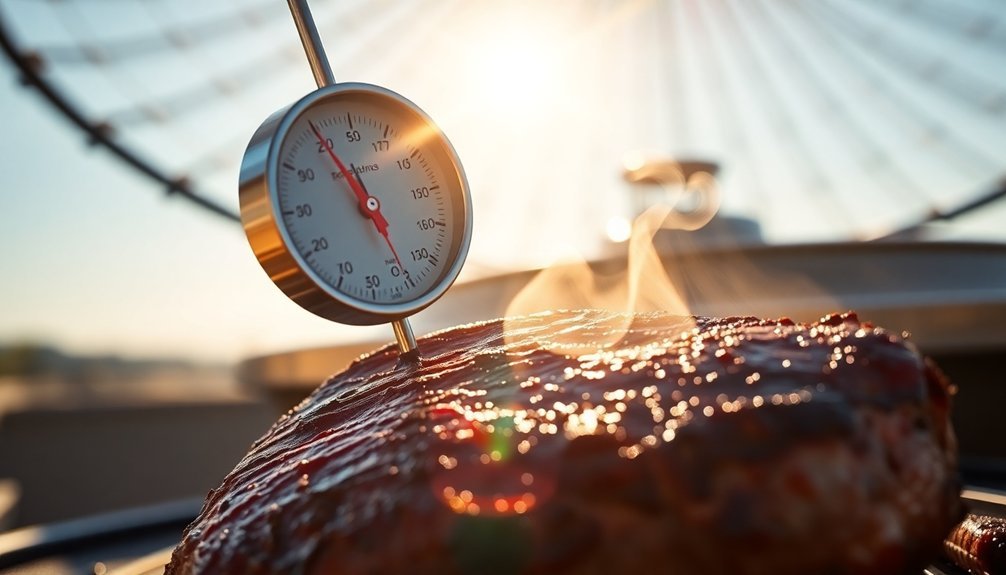
Proper preheating sets the foundation for successful solar cooking, just as reaching safe temperatures guarantees food safety.
You'll need to preheat your solar cooker for at least an hour before cooking meat, though some dishes may only require 15-20 minutes.
To maximize heat during preheating, verify you've focused the cooker directly at the sun and keep the cover fully zipped. 11am-4pm provides optimal sunlight conditions for efficient preheating.
You'll want to adjust the cooker's position regularly, using its shadow as an alignment guide. This is especially important during winter months when the sun sits lower in the sky.
Use dark cookware, particularly cast iron, to enhance heat absorption and retention.
Don't use aluminum foil, as it reflects heat away.
Keep a thermometer handy to monitor internal temperatures, and always use oven mitts when handling the hot cooker.
Choosing The Right Thermometer
Selecting the right thermometer for your solar cooker can make the difference between perfectly cooked meat and potentially unsafe food.
You'll find two main options: infrared and probe thermometers.
Infrared thermometers offer quick surface temperature readings with dual-laser precision and a range up to 1022°F.
However, you'll need to remove the pot for accurate measurements, and they can't read through glass.
They're great for checking cooking surfaces but not food interiors.
Probe thermometers are your best bet for meat.
They provide direct food temperature readings up to 572°F and come with useful features like timers and alarms.
You can leave the probe in while cooking, and they're more reliable for ensuring food safety.
Plus, they're not affected by steam or reflective surfaces that might throw off infrared readings.
Safe Poultry Cooking Guidelines
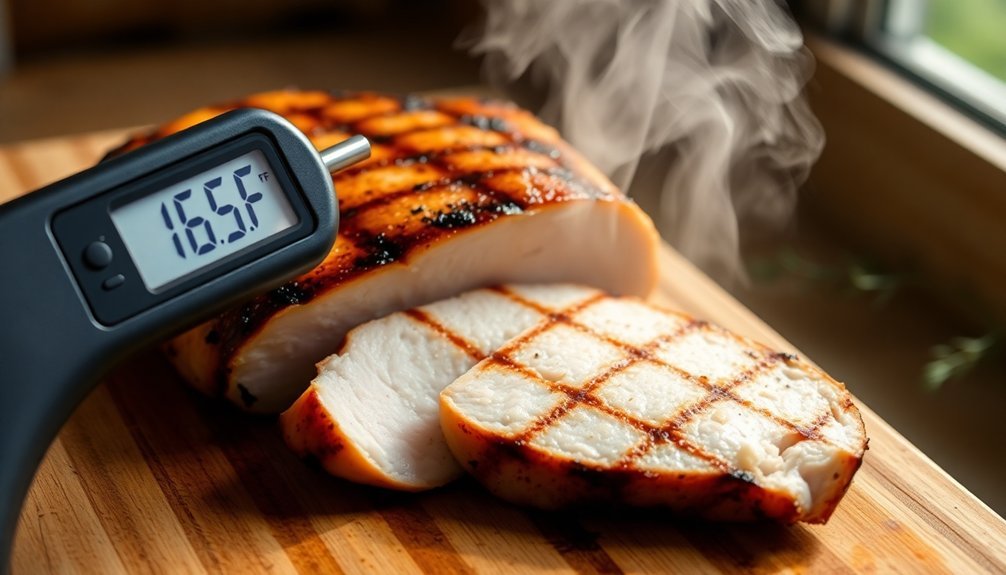
You'll need to cook all poultry to a minimum internal temperature of 165°F (74°C) for safe consumption, regardless of your solar cooking method.
When checking temperatures with your thermometer, focus extra attention on dark meat areas like thighs and drumsticks, as they typically take longer to reach safe temperatures.
Remember to insert your thermometer into the thickest part of the meat without touching bone, which could give you an inaccurate reading.
Chicken Temperature Safety Basics
Food safety champions know that cooking chicken to the right temperature is essential for preventing foodborne illness.
You'll need to cook your chicken to a minimum internal temperature of 165°F to guarantee it's safe to eat. When checking the temperature, insert your meat thermometer into the thickest part of the meat, avoiding any bones.
Here are your key temperature safety guidelines for chicken:
- Always verify the internal temperature reaches 165°F for all chicken parts
- Use a meat thermometer in the thickest section, away from bones
- Don't rely on color or texture to determine doneness
- Check multiple spots if cooking a whole bird
While some chefs use time-temperature pasteurization at 155°F, stick to the standard 165°F unless you're experienced with specialized cooking methods.
Monitoring Dark Meat Temps
Dark meat chicken presents unique temperature requirements that differ from breast meat. While the USDA requires a minimum of 165°F for safety, you'll want to aim higher for the best results.
For ideal texture and flavor, cook your dark meat to 170-175°F. This higher temperature range helps break down connective tissue, making your chicken legs and thighs more tender and juicy.
Don't worry about drying out the meat – dark meat can handle these higher temperatures well.
You'll need a reliable food thermometer to monitor the internal temperature. Insert it into the thickest part of the meat to guarantee accurate readings.
If you're using a slower cooking method, you can achieve safe results at 157°F by holding the temperature for at least 31 seconds, following USDA pasteurization guidelines.
Ground Meat Temperature Requirements
You'll need to cook your ground meat to a minimum temperature of 160°F (71°C) for beef, pork, and lamb, or 165°F (74°C) for poultry to guarantee it's safe to eat.
When using your thermometer, check multiple spots in the thickest parts of the meat, especially for larger portions or irregularly shaped patties.
Until you're ready to cook, keep your ground meat in the refrigerator at or below 40°F (4°C) and use it within two days of purchase, or freeze it for longer storage.
Safe Minimum Cooking Point
When cooking ground meat outdoors with solar energy, maintaining proper temperatures isn't just a suggestion – it's essential for food safety.
You'll need to verify your ground meat reaches specific minimum temperatures to kill harmful bacteria and prevent foodborne illness.
- Heat ground beef, pork, lamb, and venison to 160°F (71°C)
- Cook ground poultry like chicken and turkey to 165°F (74°C)
- Insert your meat thermometer into the thickest part, or horizontally for thin patties
- Keep cooking until you maintain the safe temperature for the entire portion
Checking Multiple Spots
To guarantee your ground meat is thoroughly cooked in a solar setup, checking multiple spots with a reliable thermometer becomes crucial for food safety. You'll need to check each piece individually, especially when cooking multiple portions like hamburger patties. Insert your thermometer into the thickest part of each piece, avoiding bone and fat.
| Location | What to Check | Why It Matters | Best Practice |
|---|---|---|---|
| Center | Core temp | Slowest to heat | Check first |
| Edges | Outer temp | Can overcook | Monitor frequently |
| Bottom | Base temp | Solar heat variation | Check for evenness |
| Top | Surface temp | Direct exposure | Prevent burning |
For larger portions, like meatloaf, you'll want to test at least three different spots to ascertain uniform doneness. Remember that thickness and composition can affect how quickly your meat reaches safe temperatures in solar cooking.
Ground Meat Storage Tips
Proper storage of ground meat plays a critical role in solar cooking safety and food quality.
You'll need to store ground meat at temperatures between 2°C and 4°C to slow bacterial growth and maintain freshness. Place raw ground meat below cooked foods in your refrigerator and use covered containers to prevent cross-contamination.
Follow these essential storage guidelines:
- Store ground meat immediately after purchase, and don't leave it at room temperature for more than 2 hours.
- Maintain your refrigerator's temperature at 4°C or below, avoiding overcrowding that could cause temperature fluctuations.
- Label and date all packages clearly, following the FIFO (First In, First Out) rotation system.
- Keep raw ground meat separate from other foods, using designated storage containers and areas.
Whole Cut Temperature Standards
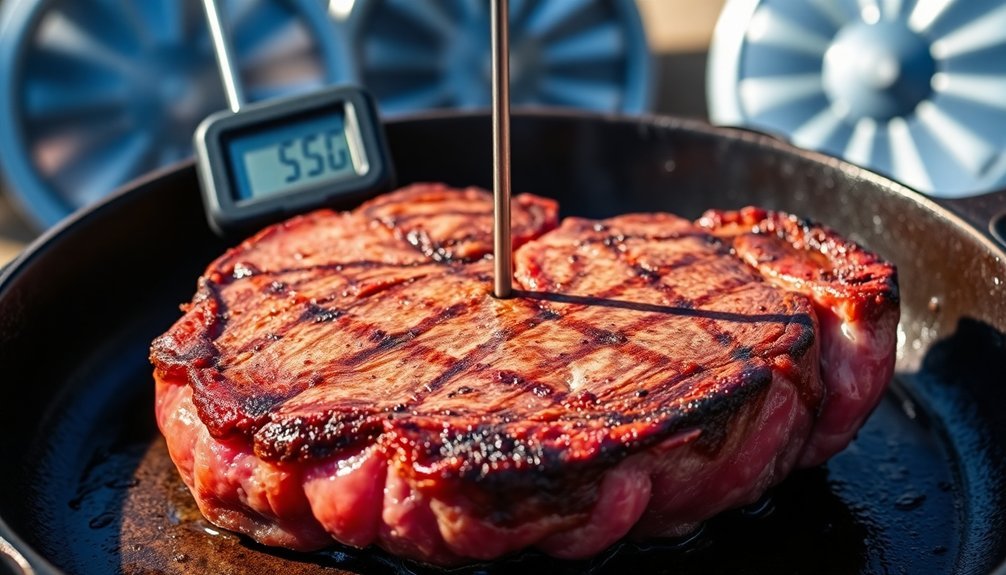
Safety standards for whole cuts of meat establish precise temperature requirements that guarantee both food safety and ideal dining experience.
For beef, veal, lamb, and pork, you'll need to reach an internal temperature of 145°F (63°C), followed by a three-minute rest period.
You'll find these standards differ from ground meats because whole cuts only have surface contamination risks. The rest time guarantees even heat distribution while maintaining the meat's juiciness and tenderness.
Don't confuse these guidelines with those for poultry, which requires 165°F (74°C), or ground meats needing 160°F (71°C).
When you're checking temperatures, remember that these standards specifically apply to intact cuts like steaks and roasts, not mechanically tenderized or injected meats, which require higher temperatures for safety.
Checking Internal Meat Temperature
Mastering internal meat temperature checks stands as your essential defense against foodborne illness when solar cooking.
You'll need to select the right thermometer for your solar cooking setup, with digital instant-read models offering quick results and wireless options providing convenient monitoring without opening your solar oven.
- Insert the probe into the thickest part of your meat, avoiding bones and fat for accurate readings.
- Wait for the temperature reading to stabilize before making any cooking decisions.
- If you're cooking thin cuts, insert the thermometer from the side.
- Use multiple probes for larger cuts or when cooking several pieces.
Always clean your thermometer before and after use, and remember to calibrate it regularly using ice water for consistent accuracy in your solar cooking adventures.
Temperature Maintenance During Cooking
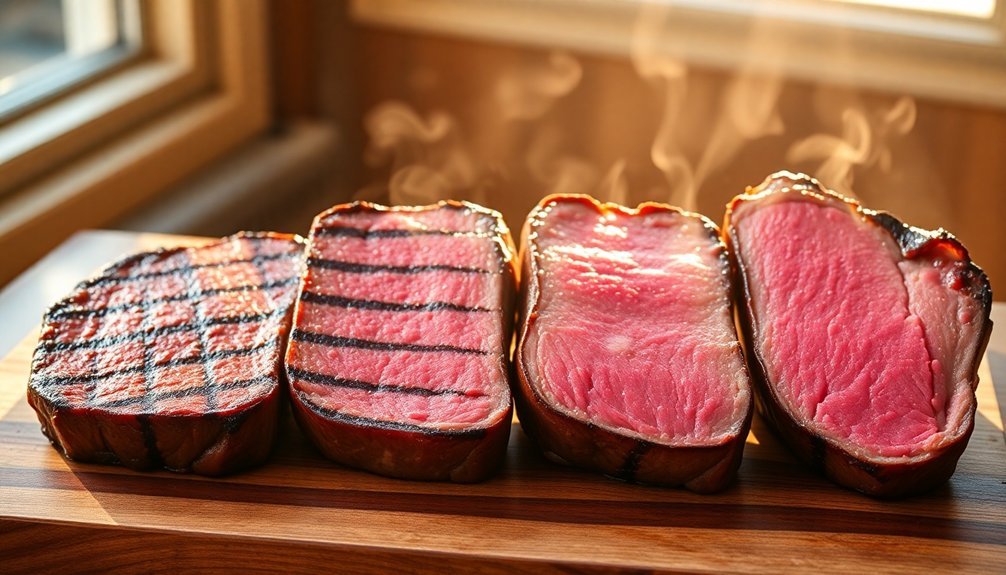
When cooking with solar power, maintaining consistent temperatures requires careful attention to both positioning and insulation techniques.
You'll need to reposition your solar oven every 30-45 minutes to track the sun's movement and maintain ideal heat levels between 150-225°F.
To preserve heat effectively, don't open the oven cover unnecessarily, as this can drop temperatures by 50-100°F.
Keep your cookware dark-colored and lidded to maximize heat absorption. If temperatures climb too high, you can turn the oven slightly away from direct sunlight.
For best results, use multiple layers of insulation around your cooking cavity and verify your glazing material is securely sealed.
Remember to vent the box properly to prevent steam buildup, which can interfere with sunlight penetration and affect cooking temperatures.
Solar Cooking Weather Considerations
Although solar cooking offers an eco-friendly way to prepare meals, your success depends heavily on local weather patterns and seasonal changes.
You'll want to check weather conditions before starting, as cloud cover, wind, and precipitation can greatly impact your cooking time and temperature stability.
- Choose peak cooking hours between 11:00 AM and 3:00 PM, when sunlight is most intense
- Protect your solar oven from wind to maintain consistent temperatures
- Plan longer cooking times during winter months and adjust your oven angle more frequently
- Use thermal mass like rocks or bricks to retain heat during colder seasons
For best results, you'll need clear skies and direct sunlight.
If you're in a cloudy climate or coastal area, schedule your solar cooking on days with favorable weather forecasts and maintain consistent sun alignment throughout the cooking process.
Temperature Zones For Food Storage
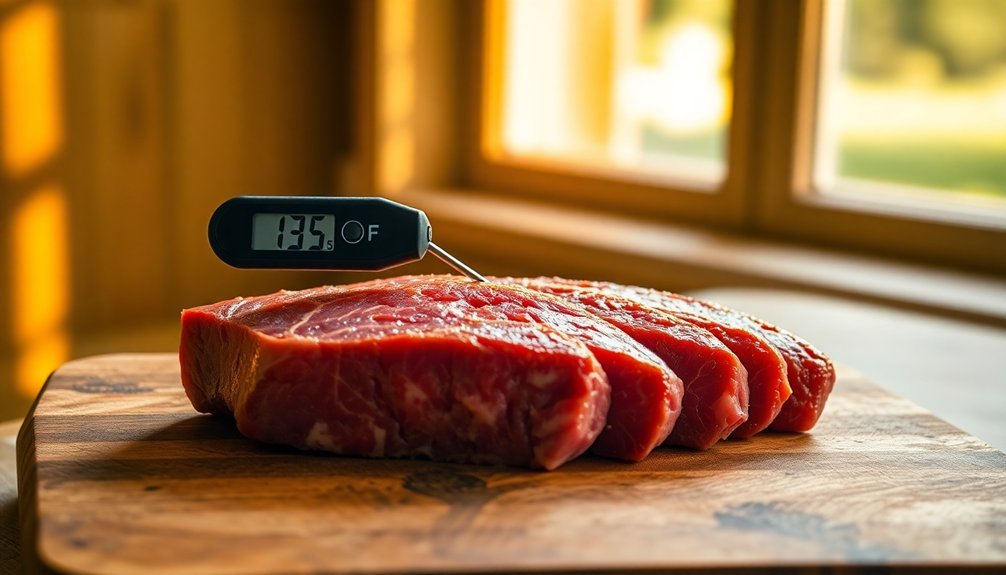
You'll need to be vigilant about proper cold storage, keeping all perishable foods at or below 40°F to prevent bacterial growth.
When storing raw meats, maintain temperatures between 33-36°F and place them on the bottom shelf to prevent drips from contaminating other foods.
Your highest risk comes from leaving foods in the danger zone between 41-135°F, where bacteria multiply rapidly, so never leave perishables at room temperature for more than 4 hours.
Cold Storage Safety Basics
Proper food storage temperature control serves as your first line of defense against foodborne illness.
You'll need to keep perishable foods out of the danger zone (40°F to 140°F) where bacteria can double every 20 minutes. Store all meats, dairy, and produce at 40°F or below in your refrigerator to prevent bacterial growth.
Follow these essential cold storage guidelines:
- Store raw meats below ready-to-eat foods to prevent cross-contamination
- Keep fresh meat cuts between 36°F and 39°F on covered plastic or stainless steel trays
- Don't leave perishable foods at room temperature for more than 2 hours (1 hour if above 90°F)
- Use individual meat cuts within two days and store boned meat no longer than three days
Hot Zone Danger Risks
While cold storage protects your ingredients before cooking, understanding hot zone dangers remains equally important for food safety. When food temperatures fall between 40°F and 140°F, bacteria can double every 20 minutes, creating serious health risks.
You'll need to keep hot foods at or above 135°F using steam tables or holding cabinets. If your food drops below this temperature for more than 4 hours, you must discard it.
During reheating, bring foods to 165°F within 2 hours to kill harmful bacteria like Salmonella and E. coli. Monitor temperatures frequently with a reliable thermometer, and always stir hot foods to distribute heat evenly.
Frequently Asked Questions
How Long Can Meat Stay Warm in a Solar Oven After Cooking?
You can keep meat warm in your solar oven for up to 4 hours after cooking, but you'll need to maintain temperatures above 125°F and use insulated cookware to prevent the food from entering the danger zone.
Can Marinades Affect Temperature Readings When Using a Meat Thermometer?
Don't worry about marinades affecting your thermometer readings – they won't interfere. Whether you're using acidic, oily, or spice-heavy marinades, you'll still get accurate temperature readings when checking your meat's doneness.
Should Meat Be Covered or Uncovered When Solar Cooking?
You'll want to cover your meat while solar cooking to retain moisture and prevent overcooking. Use dark, heat-retentive cookware with tight-fitting lids instead of aluminum foil, which can reflect heat away.
Does Altitude Affect Required Cooking Temperatures in Solar Ovens?
No, altitude won't affect your required cooking temperatures in a solar oven. You'll still need to reach the same safe internal temperatures for meat, though cooking times may vary due to different boiling points.
Can Frozen Meat Be Placed Directly Into a Solar Oven?
Yes, you can place frozen meat directly in a solar oven, but you'll need to cut it into smaller chunks first. This helps it defrost and cook more evenly, ensuring safe internal temperatures.
In Summary
You've now got the essential knowledge to safely cook meat in your solar oven. Remember to maintain temperatures between 165°F-185°F for poultry and 145°F-160°F for other meats. Always use a reliable meat thermometer, check internal temperatures at the thickest point, and factor in weather conditions. With these temperature guidelines and safety practices, you'll enjoy perfectly cooked solar meals every time.





Leave a Reply